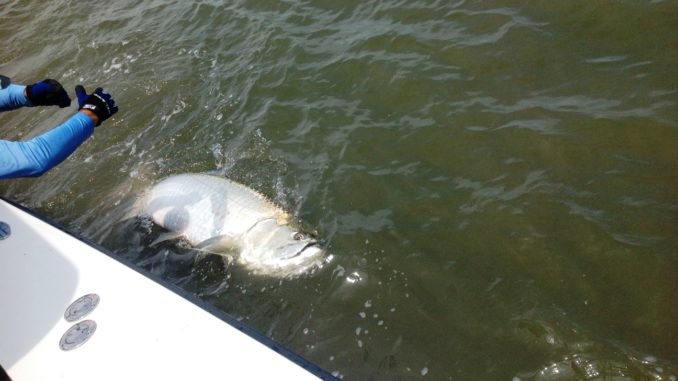
Frying Pan Shoals divides area into distinct fisheries for silver kings
Tarpon, aka silver kings, bring excitement to fishermen at their mere mention. These big fish make summer forays into the waters of the Carolinas, and one place that attracts a visiting tarpon population each summer is the area around the mouth of the Cape Fear River. This usually begins around the July full moon, this year, July 9.
The Cape Fear, which is the only large North Carolina river that flows directly into the ocean, begins just below Jordan Lake Dam and collects numerous smaller rivers and creeks on its journey to the ocean between Bald Head Island and the Caswell Beach end of Oak Island. The river flows strong and carries a lot of baitfish, which attract predators, and tarpon are one of the predators fishermen in the area eagerly anticipate each summer.
Tarpon fishing in this area is a two-pronged affair. Some tarpon are in the ocean and move along the beaches, crossing Frying Pan Shoals through ever-changing sloughs. The water on the east beach of Bald Head up to Wrightsville Beach is usually cleaner and allows spotting swimming tarpon more easily, but the fish usually find more forage in the dirtier water from Frying Pan Shoals heading west along the south beach of Bald Head Island and along Oak Island.
Tarpon also move into the lower Cape Fear River on rising tides to feed, especially when the rising tide occurs in the late afternoon or early evening on a moonlit night. Tarpon in the river are usually in the bay and creek system behind Bald Head Island, but they occasionally venture beyond or follow schools of menhaden up the ship channel.
Ocean tarpon encounters are often surprises for fishermen slow-trolling live baits for king mackerel, and the catch ratio is low. Small treble hooks are no match for a tarpon’s bony mouth. Tarpon in the sloughs crossing Frying Pan Shoals and along the edge of the shoals like chunks of cut mullet, menhaden and other oily fish soaked on the bottom.
Many fishermen use a heavy duty fish-finder rig, but a rig similar to the Owen Lupton Red Drum Rig using a pyramid sinker rather than an egg sinker has gained popularity.
Fishermen in the river look for deeper holes and thoroughfares and soak oily baits on the bottom, while also floating a live bait or two behind the boat. Often, blacktip sharks create excitement by grabbing baits and racing away, only to be recognized when they jump. Sometimes the sharks become a nuisance.
Jon Huff of Circle H Charters (www.circlehcharters.com) in Wrightsville Beach was the first guide to lead a fisherman to a fly-caught tarpon in this area in 2015. Huff said all of his fly caught tarpon have hit peanut butter (purple/black) toad flies.





Be the first to comment